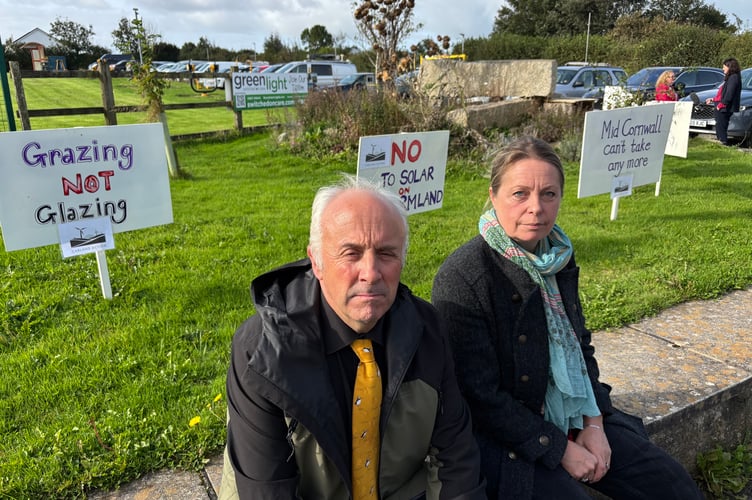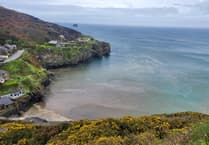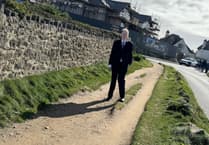A government inspector arrived at a Cornish community centre yesterday (Tuesday, September 16) to be greeted with banners saying ‘Don’t flood Cornwall with solar’, ‘Grazing not glazing’, ‘No to solar on farmland’ and ‘Mid Cornwall can’t take any more’.
Those opposed to a bid to build what would be Cornwall’s largest solar farm in a valley just outside Truro certainly made their feelings known at a one-day planning appeal at St Erme Community Centre.
Following a protest in November outside County Hall / Lys Kernow in Truro by those opposing the Fairpark solar farm in the Hendra valley near Mitchell, a Cornwall Council planning committee refused the application, going against their own officers’ warnings that it could lead to an expensive appeal.
Those warnings proved true and Downing Renewable Developments submitted an appeal application to the Planning Inspectorate in May, with the hearing taking place on Tuesday.
Nick Dymond and Tash Haslam-Hopwood on why they are against what would be Cornwall's biggest solar farm if approved on appeal
Some of the people who protested against the 125,000-panel solar farm – which has previously been likened to a “glass and concrete prison” – were among those that spoke against the solar farm at today’s appeal. The original application was refused on the grounds that it would harm the character of the immediate rural landscape, “particularly when viewed from nearby roads and public rights of way notwithstanding the mitigation and enhancement measures proposed”.
Carland Action Group, which was formed by a large number of concerned people living in the area, issued its own report to the Bristol-based Planning Inspectorate, prior to today’s hearing, outlining a number of reasons why it believes the decision should not be overturned to install the solar farm on 85 hectares (210 acres) of land.
Downing Renewable Developments argues that any impact will be limited in nature and scale and only temporary, with “residual positive impacts on the landscape and biodiversity likely to result beyond the 30-year operational period”. The company stressed there will be no direct impact on the countryside beyond the appeal site.
The appeal document also states that the nature of the local topography, combined with the field and hedgerow network and a patchwork quilt of woodlands, would mean that the solar farm’s visual impact in the surrounding area would be very limited. “This makes the appeal site a good location for this form of development,” argues Downing.

The company also asserts that the solar farm would be “sustainable development” and there are no material reasons why planning permission should be refused.
However, residents living in the area between Trispen, St Erme, Ladock and Mitchell disagree. Speaking before today’s meeting, Tash Haslam-Hopwood told us: “I’m here with Carland Action Group who say Cornwall has had enough of these vast solar panel farms which are not really delivering benefits for the local community.”
Local farmer Nick Dymond is primarily concerned about the loss of agricultural land. “There are so many concerns about this development, but I have a real fear about whether we will be able to feed ourselves in the future.”
At just over 200 acres within the parishes of Ladock and St Erme, it would be the largest solar farm in Cornwall if the inspector overturns Cornwall Council’s decision to refuse.
“Up until now, we’ve seen around 50- to 60-acre farms, so we’re talking four or five times the scale of what we’ve seen before, which will be a shock,” said Ms Haslam-Hopwood. “Then we have the fact that from here are there are ten separate solar farms. We’d be joining these up, so we’re going to have vast areas of plastic taking away from food and farming.”
“The real concern for me is the infrastructure bill [the proposed Planning and Infrastructure Bill] which will give solar farms the strength for compulsory purchase of adjoining land. I can see that in areas like this where we’ve got a proliferation that it will become one mass solar farm once these compulsory purchase orders are realised next year,” added Mr Dymond.
Ms Haslam-Hopwood said: “We won the day back in November and here we are fighting the same problems yet again with a vast team of professionals against the little guy.”
The hearing, overseen by planning inspector Rosalyn Kirby, heard submissions from Cornwall Council officers, headed by principal development officer James Holman, and representatives from applicant Downing Renewable Developments and its representative Pegasus Planning Group as well as residents opposed to the solar farm. Among those were representatives from Carland Action Group and local councillor Karen Glasson.
The debate took in planning policy, the effect of the proposal on the character and appearance of the area, on agricultural land and food security, on biodiversity and flooding, and highways and fire safety.
The inspector was due to end the hearing with a site visit to the area where the solar farm would be built, including businesses based at Hendra Barns, which say they will be detrimentally affected. The inspector’s decision will be announced at a later date.


.jpg?width=209&height=140&crop=209:145,smart&quality=75)

.png?width=209&height=140&crop=209:145,smart&quality=75)
Comments
This article has no comments yet. Be the first to leave a comment.